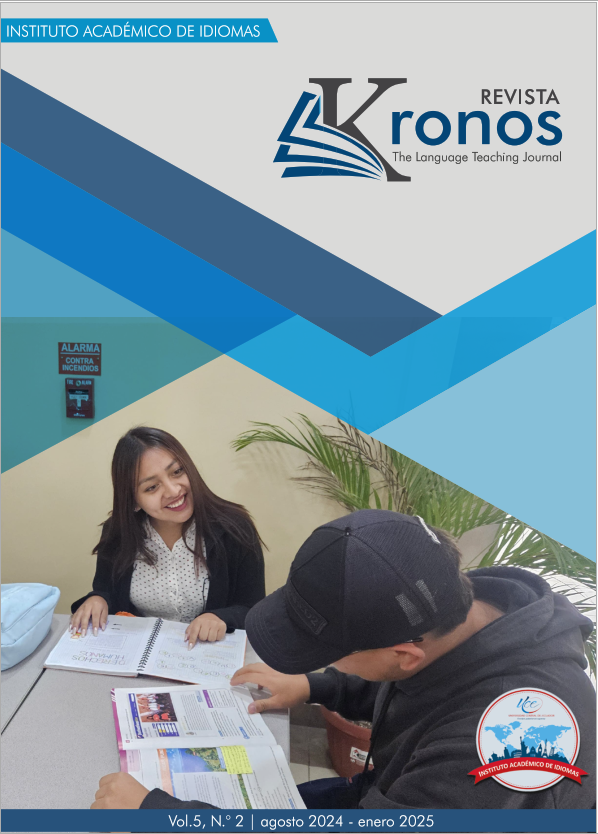Enseñanza de fonética a jóvenes estudiantes de inglés como idioma extranjero
DOI:
https://doi.org/10.29166/kronos.v5i2.7432Palabras clave:
Habilidades lectoras y escritoras, Instrucción fonética, Logro, Idioma inglésResumen
La instrucción fonética refuerza las conexiones entre letra-sonido, y amplía tanto las habilidades de apren dizaje como su significado. Si bien es cierto, la instrucción fonética se mantiene como necesaria para enseñar inglés como lengua extranjera, aún existe discrepancia en la investigación acerca de enseñar fonética a adultos jóvenes en un instituto de idiomas en una universidad pública del Ecuador. Con esta premisa, la presente investigación tiene como objetivo determinar los resultados de esquemas de fonética que ayuden a los estudiantes a entenderla de mejor manera. Empleando un enfoque de métodos mixtos con un alcance descriptivo y un diseño cuasi experimental, el estudio involucró a veintidós estudiantes de nivel A2.2 del Instituto Académico de Idiomas. Los participantes reali zaron talleres de fonética durante siete semanas. La recopilación de datos se basó en dos instrumentos principales: una encuesta que identificaba diez palabras destacadas reportadas por los docentes de A2.2 y una serie de pruebas previas y posteriores alineadas con el contenido de los talleres. Los resultados revelaron un efecto significativo en la comprensión lectora, la pronunciación y las habilidades auditivas de los estudiantes, siendo la pronunciación el logro más sustancial. Estos hallazgos subrayan la importancia de incorporar la instrucción fonética en los planes de estudio de EFL para fomentar la competencia lingüística integral
Descargas
Citas
Almuslimi, F.K.A. “Pronunciation Errors Committed by EFL Learners in the English De
partment in Faculty of Education–Sana’a University.” Millennium Journal of English
Literature, Linguistics and Translation 1, no. 2 (2020).
Andrä, C., B. Mathias, and A. Schwager. “Learning Foreign Language Vocabulary with Ges
tures and Pictures Enhances Vocabulary Memory for Several Months Post-Learning
in Eight-Year-Old School Children.” Educ Psychol Rev 32 (2020): 815–50. https:// DOI: https://doi.org/10.1007/s10648-020-09527-z
doi.org/10.1007/s10648-020-09527-z.
Cárdenas-Hagan, E. Literacy Foundations for English Learners: A Comprehensive Guide to
Evidence-Based Instruction. Brookes Publishing Co, 2020.
Caselli, M.C., P. Rinaldi, S. Stefanini, and Volterra V. “Early Action and Gesture ‘Vocab
ulary’ and Its Relationship with Word Comprehension and Production.” Child Devel
opment 83, no. 2 (2012): 526–42.
Cortina-Pérez, B., & Andúgar, A. (2021). Exploring the ideal foreign language teacher pro
f
ile in Spanish preschools: teacher education challenges. Teachers and Teaching, 27:8,
–729. https://doi.org/10.1080/13540602.2021.2004112 DOI: https://doi.org/10.1080/13540602.2021.2004112
Hanson, and A. Hanson. The Science of Reading For English Learners. Owl Hill Learning,
Labaree, R.V. “Organizing Your Social Sciences Research Paper: Quantitative Methods
[Research Guide,” XXXX. https://libguides.usc.edu/writingguide/quantitative.
Miranda, J.A., and Wahyudin A.Y.. “Pre-Service Teachers’ Strategies in Improving Students’
Speaking Skills.” Journal of English Language Teaching and Learning 4, no. 1 (2023):
–47. https://doi.org/10.1016/j.tate.2022.103937. DOI: https://doi.org/10.1016/j.tate.2022.103937
Ortín, R., and M. Simonet. “PHONOLOGICAL PROCESSING OF STRESS BY NATIVE
ENGLISH SPEAKERS LEARNING SPANISH AS A SECOND LANGUAGE.” Studies
in Second Language Acquisition 44 (2021): 460–82. DOI: https://doi.org/10.1017/S0272263121000309
ResearchGate. “The Phoneme-Level Articulator Dynamics for Pronunciation Animation,”
November 2011. https://www.researchgate.net/figure/b-standard-tongue-position
chart-of-English_fig1_254018165.
“The Speech Guide,” September 9, 2022. https://thespeechguide.com/place-manner-voice
chart/.
Tutors, Owl. “How to Teach Phonics: A Step-by-Step Guide.” Owl Tutors, November 13,
Publicado
Cómo citar
Número
Sección
Licencia
Derechos de autor 2025 Mariela Herrera Bonilla, Miriam Cuenca Fernández

Esta obra está bajo una licencia internacional Creative Commons Atribución-NoComercial-CompartirIgual 4.0.












